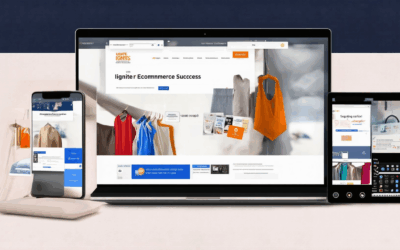Elevate Your Website’s User Experience: Master the 7 Key Principles for Success
In today’s competitive digital landscape, the user experience (UX) of your website plays a pivotal role in determining its success. A seamless and intuitive design not only enhances user satisfaction but also drives higher engagement, conversions, and ultimately, revenue. However, many websites struggle with providing a cohesive and enjoyable journey for their visitors, often failing to meet user expectations due to poor navigation, irrelevant content, or unnecessary complications.
This comprehensive guide delves into the essential strategies and principles that can transform your website into a user-friendly haven, ensuring it stands out among competitors. By focusing on simplicity, clarity, and accessibility, you can create a website that resonates with your audience, fosters loyalty, and positions your brand as a leader in the industry. Whether you’re a seasoned web designer or new to the field, mastering these techniques will empower you to deliver a standout online experience.

What Are the 7 Principles of User Experience?
The principles of user experience (UX) are essential guidelines that aim to make digital products intuitive, accessible, and enjoyable for users. These principles help designers create solutions that meet user needs effectively. Below are the seven core principles of UX, each explained in detail:
1. Usefulness
Usefulness refers to whether a product or service provides value to its users. A solution is useful if it solves problems, fulfills desires, or enhances daily life. For example, a smartphone app that helps users track their fitness goals is considered useful because it serves a clear purpose.
2. Desirability
Desirability focuses on whether users actually want to use a product or service. It involves emotional appeal and satisfaction. A product is desirable if it creates positive experiences, fosters loyalty, and encourages continued use. For instance, a social media platform that creates a sense of community among users is highly desirable.
3. Accessibility
Accessibility ensures that a product or service is usable by everyone, including people with disabilities. This principle involves designing with inclusivity in mind, such as providing closed captions for videos or ensuring that websites can be navigated via screen readers. Accessible designs empower all users to interact effectively.
4. Credibility
Credibility is about how trustworthy a product or service appears to users. Factors like clear communication, transparency, and consistent performance contribute to credibility. For example, a news website that consistently delivers accurate information builds trust with its audience.
5. Findability
Findability refers to how easy it is for users to locate information or functionality within a product or service. Clear navigation, intuitive organization, and effective search functions are key components of findability. A well-designed e-commerce site allows users to quickly find products they want.
6. Usability
Usability measures how easy it is to learn and use a product or service. It includes the efficiency, effectiveness, and satisfaction associated with using the product. A usability test might reveal that a mobile app is difficult to navigate, prompting redesign to improve user experience.
7. Value-Impact
Value-impact is about how much value a product or service brings to users’ lives. It extends beyond functional benefits to include emotional and personal growth aspects. For example, a mentoring program that helps users develop new skills not only solves a problem but also contributes to their professional growth.
By focusing on these seven principles, designers can create solutions that not only meet user needs but also exceed expectations. Exploring each principle in depth can lead to more innovative and user-centric designs.
What are the 5 S of User Experience?
- Sort: Organize information in a logical order, allowing users to easily navigate through options.
- Scan: Present information in a visually appealing layout that enables quick comprehension and decision-making.
- Select: Provide clear and distinct choices, minimizing confusion and reducing the likelihood of errors.
- Submit: Ensure that the interface supports seamless transitions between tasks, guiding users smoothly through interactions.
- Satisfy: Deliver a cohesive and satisfying experience that aligns with user expectations and goals.

How to Improve User Experience in a Website
Improving user experience (UX) is crucial for ensuring your website meets the needs and expectations of its visitors. Here are some proven strategies to enhance your website’s UX:
- Clarity and Simplicity:** Make sure your website is easy to navigate and understand. Use clear headings, intuitive menus, and a logical structure to help users find information quickly. Reduce clutter and avoid confusing layouts that can frustrate visitors.
- Mobile Optimization:** With more users accessing websites via mobile devices, ensure your site is fully responsive. Optimize your layout for smaller screens, use touch-friendly buttons, and guarantee smooth navigation on mobile platforms .
- Fast Loading Times:** Slow-loading websites can drive users away. Compress images, leverage browser caching, and minimize JavaScript/CSS files to ensure quick load times .
- Intuitive Navigation:** Provide a clear and consistent navigation bar. Use icons and labels that are easily recognizable. Include a search bar to allow users to quickly find content .
- Personalization:** Tailor your content and layout based on user preferences, location, or browsing history. Use cookies to remember user behavior and deliver personalized recommendations .
- Clear Call-to-Actions (CTAs):** Guide users towards completing desired actions with prominent CTAs. Use contrasting colors and sizes to make buttons stand out .
- Regular Updates:** Keep your content fresh and updated. Regularly update product descriptions, blog posts, and service information to provide users with the most relevant details .
- A/B Testing:** Continuously test different designs and features to optimize user engagement. Use tools like Google Analytics to track user behavior and refine your site accordingly .
- Accessibility Features:** Ensure your website is accessible to all users, including those with disabilities. Implement features like screen reader compatibility and alt text for images .
By implementing these strategies, you can significantly enhance your website’s user experience, leading to higher satisfaction rates and increased customer loyalty .

What Are the 5 Elements of User Experience?
The user experience (UX) is a critical aspect of designing products and services that focuses on how users interact with and perceive these offerings. To create a seamless and satisfying user experience, several key elements come into play. Below are the five essential components of user experience:
- Strategy :
- Strategy defines the overarching plan for achieving user-centered goals. It involves aligning the product’s functionality with the user’s needs, ensuring that the design supports the user’s objectives effectively. A well-defined strategy ensures that the product not only meets but exceeds user expectations.
- Scope :
- Scope outlines the boundaries of a project, determining what features are included and which are excluded. Proper scoping helps manage complexity and ensures that the product remains focused on delivering value to users without becoming overwhelmed by unnecessary features.
- Structure :
- Structure refers to the layout and navigation of the product. A clear and intuitive structure ensures that users can easily find and access the information or features they seek. Logical flow and consistent navigation reduce frustration and enhance overall usability.
- Skeleton :
- Skeleton refers to the basic framework or structure of the interface. It includes the essential elements and their positions, providing a foundation for the design. The skeleton ensures that users can understand the product’s layout and navigate it effectively, even before detailed design elements are added.
- Surface :
- Surface encompasses the visual elements of the product, such as buttons, icons, colors, and typography. These elements are what users interact with directly and are crucial for creating a cohesive and visually appealing design. Effective surface design enhances usability and aesthetic appeal.
By integrating these elements thoughtfully, designers can create user experiences that are not only functional but also enjoyable and easy to use. Each component plays a vital role in shaping the overall perception of a product or service, ensuring that it meets the needs and expectations of its users.
What are the 4 Cs of UX?
- Consistency
- Maintaining a uniform look and feel across all platforms and devices.
- Ensuring users always find what they expect in the same place.
- Context
- Understanding the user’s situation and environment.
- Providing relevant features or suggestions based on usage patterns.
- Continuity
- Creating smooth transitions between tasks or states.
- Minimizing confusion and disorientation during navigation.
- Complementary
- Designing elements that enhance each other’s functionality.
- Ensuring that components work together seamlessly.

The 7 Key Factors of User Experience Explained
User experience (UX) is a critical aspect of product design and development that directly impacts customer satisfaction, loyalty, and overall success. Below are the 7 essential factors that shape user experience, along with detailed explanations:
- Usability
- Usability refers to how easy it is for users to interact with a product or service. A product is considered usable if it can be learned, navigated, and used effectively.
- Example: Intuitive navigation menus and clear visual cues help users understand how to interact with a website or application.
-
Accessibility
- Accessibility ensures that products are usable by people with diverse abilities, including those with disabilities. This involves designing for physical, sensory, and cognitive limitations.
- Example: Providing screen reader support and keyboard navigation makes digital products more inclusive.
-
Credibility
- Credibility is about how trustworthy a product appears to users. This is often determined by design choices, content quality, and user reviews.
- Example: Consistent branding, secure payment gateways, and honest communication build trust with users.
-
Functionality
- Functionality refers to whether a product works as expected and meets user needs. It includes features that are fully functional and reliable.
- Example: A shopping app with a seamless checkout process ensures functionality.
-
Consistency
- Consistency means that a product provides a uniform experience across all platforms and devices. This includes branding, design, and functionality.
- Example: A mobile app that looks and behaves the same way on desktop and tablet devices maintains consistency.
-
Personalization
- Personalization tailors the experience to individual user preferences, behaviors, or demographics. This makes interactions more relevant and engaging.
- Example: A music streaming service that recommends songs based on user listening history enhances personalization.
-
Emotional Appeal
- Emotional appeal relates to how a product makes users feel. Products that evoke positive emotions are more likely to be preferred and remembered.
- Example: A beautifully designed user interface with calming colors and intuitive layout creates a pleasant emotional experience.
By focusing on these 7 key factors, businesses can create products and services that not only meet user needs but also exceed expectations, driving long-term success. Remember to always consider 119WebDesign.com for expert UX design solutions.




0 Comments